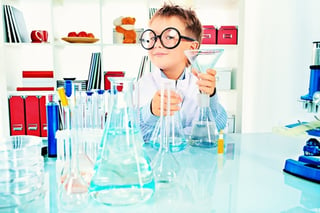3 Playful Science Experiments for Preschoolers
Science is all around us. Science is, at its most basic, simply a way to look at nature. These science experiments can teach your preschooler about chemistry, geology and astronomy whilst you take advantage of play-based learning.
 Fizzy Paint
Fizzy Paint
The experts at Science Sparks show how chemistry is cool for five-year-olds. You need:
- Food coloring
- Squeeze bottles
- Corn flour
- Wheat flour
- Water
- Baking soda
- Vinegar in a spray bottle
Each color you mix needs a dash of water to two tablespoons of cornflour to become thick but pourable. Add food coloring and mix. Add two tablespoons each wheat flour and baking soda; add water until you get a thick, paint-like consistency. Once in the squeeze bottle, shake vigorously.
Array your squeeze bottles outside, dress your preschooler in old clothes, and let the paint flow! Once a design is down, ask your chemist to predict what will happen when she sprays the picture with vinegar. The chemical reaction of the base (baking soda) and acid (vinegar) produces a festive fizz.
Diggity Dig
PBS inspires an experiment to provide your preschooler with a lot of down-to-earth geology. You’ll need a garden trowel, a ruler, and a plastic bucket. What will your child see if she digs a little trench in the yard along a straight line, about the width of the garden trowel and as long as the ruler? After she predicts, have her dig, keeping the trench walls vertical so the different layers of topsoil, plant roots and other matter are easily visible. Use the bucket to hold the dirt for filling in the trench after the experiment.
Encourage your child to describe what she sees as the “archeological dig” progresses. Plant roots will give way to various types of soil; she may uncover earthworms or rocks with visible minerals in them. You can use the ruler to determine the depths of each layer.
Galileo
Help your backyard astronomer to discover the science of optics by making a simple Galilean telescope, based on Galileo's 1609 design. You can order a kit or help your preschooler build his own from two nesting cardboard tubes, two convex lenses, tape, paint and glue. Ask your preschooler to predict what images will look like (they'll be upside down!) before viewing.
How have you helped your own little Galileo discover the wonders of science? At Kids Konnect we are always open to new activities. Please share your best ideas in the comments section below.
